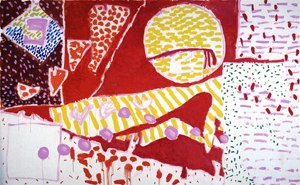
Red Garden Painting: June 3-5 1985. Oil on canvas

The exhibition of the British artist Patrick Heron, which covered his early figurative and later complete abstractions, featured fascinating vignettes of his life. The first retrospective show of Heron’s work in over twenty years, highlights Heron as a driving influence behind the St Ives School. As a critic, Heron made commanding arguments for abstraction, pushing the boundaries of what art could achieve.
I was enticed by the vibrancy of colour Heron chose to utilize in his paintings. It stayed in my mind. Both during and after I visited the exhibition it was, and still is, quite impressive. As a prominent representative of the genre, Heron’s work suggests that British Modernism sought direction and inspiration by peeking over the English channel at the French schools of art. After engaging with Heron’s paintings, particular French artists appear to have influenced his work more than others. Cezanne, Braque, and Matisse are three notable influences, but another stands above the rest, Pierre Bonnard.
Heron’s frequent usage of informally arranged interior spaces, several of which have garden views or references, is derived from Bonnard’s compositional and thematic choices.
Not enough focus is given to Heron’s writing, which results in a lack of context for important parts of this exhibition. More information about his tenure as an art critic would add another dimension to the show’s narrative. However, the time-line presented does highlight some prominent moments in Heron’s career, but it gives no indication as to how Heron can be placed in a broader art historical context.
As an artist, Heron made specific choices regarding colour, form, size, and spacing in his paintings. The manner in which he executed those choices is the true brilliance of his work. It allows the viewer to develop an individualized response and relationship to his creations. In a sense, Heron allows the viewer to put the finishing touches on the paintings.
I am thankful for having seen this exhibition and for being introduced to an authority on abstract painting. As a movement and genre of art, Modernism is quintessentially European. Author and art historian Serge Guilbaut has suggested that New York became the centre of Modern art during the 20th century. However, Heron’s body of work throws a wrench into the mechanisms of that claim. No artist in the States painted like Heron did. I was educated and trained as an art historian in the States and Heron’s name was never mentioned. Undoubtedly, this is a result of Heron not being included within the Greenberg domain.
I am inspired by this exhibition to lift that veil and pursue and research art beyond that sphere.
Alexander Stanfield
Turner Contemporary Museum Margate, Kent UK. Fri 19 Oct 2018 – Sun 6 Jan 2019
Volume 33 no 3 January / February 2019 p24
Alexander started the New Art Examiner’s online course teaching critical writing in November, and we are delighted to print his first published piece.


Hi Alexander,
I really enjoyed reading your article on Patrick Heron. Your conclusion left much to think about:
“Author and art historian Serge Guilbaut has suggested that New York became the centre of Modern art during the 20th century. However, Heron’s body of work throws a wrench into the mechanisms of that claim. No artist in the States painted like Heron did. I was educated and trained as an art historian in the States and Heron’s name was never mentioned. Undoubtedly, this is a result of Heron not being included within the Greenberg domain. I am inspired by this exhibition to lift that veil and pursue and research art beyond that sphere.”
I look forward to reading more of your articles in the New Art Examiner in the future.
It is true; Greenberg was a mighty influence. His time was different from ours; I sense a change is taking place which is evident in the political and social situation in the USA, UK, and France and other countries. Art reflects culture or is in itself a visual culture. It is time for a serious reconsideration of Greenberg and his time. The art world is brutal, as is the world of fake news, known as Public Relations. The New Art Examiner (The Independent voice of the visual arts) has struggled against the power plays of special interests. Patrick Heron is one casualty but there are many more. Heron was also an informed critic. Critical writing is not a popular activity; there is the need for much discussion on many fronts. I believe it is only artists and writers of art who can bring some light into these dark times.
Hi Karen,
Thank you for taking the time to read my article. I am glad to know that you enjoyed reading it.
Cheers!
Hello Alexander,
I wonder if you could tell me about your experience in the online critical writing course you took with the New Art Examiner.
Thank you and best regards,
Stanley
Hello Stanley,
I would definitely recommend taking the course. I come from an academic background due to may Art History education. As a result, my writing style, for better or worse, is representative of that training. I took their course because I wanted to explore editorial writing and see if I enjoyed it. I could not be happier with my decision. Not only has my writing repertoire expanded, but I have also created some fantastic connections with the NAE staff. The once-per-week Skype meetings helped to keep me engaged. The staff are very knowledgeable, helpful, and accommodating with your schedule. If you are curious about the course and are looking to improve your writing skills, or even just want to explore what it is like to work with a publication, I highly recommend enrolling in the course.